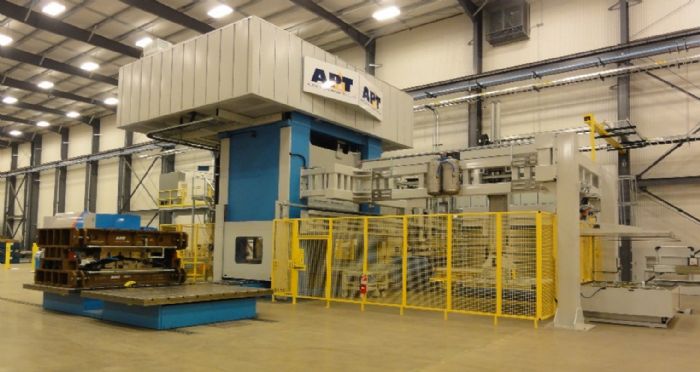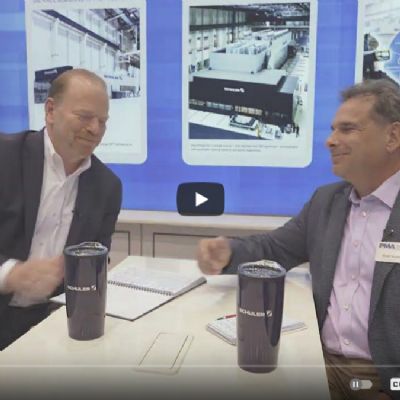AHSS Application Guidelines Specific to PHS
 All of the above-mentioned topics will be covered at this year’s Hot Stamping Experience and Tech Tour. Of note: the Advanced High Strength Steels Application Guidelines, published by WorldAutoSteel, presents global best practices and lessons learned on the metallurgy, forming and joining of AHSS grades. Conference presenters Eren Billur, author of a book on hot stamping, and Danny Schaeffler, president of Engineering Quality Solutions and chief content officer of 4M Partners, will present information from the guidelines specific to press-hardened steels, including:
All of the above-mentioned topics will be covered at this year’s Hot Stamping Experience and Tech Tour. Of note: the Advanced High Strength Steels Application Guidelines, published by WorldAutoSteel, presents global best practices and lessons learned on the metallurgy, forming and joining of AHSS grades. Conference presenters Eren Billur, author of a book on hot stamping, and Danny Schaeffler, president of Engineering Quality Solutions and chief content officer of 4M Partners, will present information from the guidelines specific to press-hardened steels, including:
- Their history in automotive applications;
- The numerous production methods available; and
- How a single stamping can have tailored properties in different regions.
“In addition,” says Schaeffler, “the 2021 edition of the book transitioned the content to an online database, available at AHSSinsights.org. There now are more than 150 articles with more than 1000 citations linked back to the original sources. You can read more about this in my Science of Forming column in the October issue of MetalForming.”
According to Billur, and included in the presentation, “several PHS grades already are available, with options having tensile strength ranging from 1000 to 2000 MPa after full hardening. PQS grades can pair with PHS grades in the hot stamping process to create areas of lower strength but higher ductility, as well as cut-edge stretchability and excellent energy absorption. Danny and I also will discuss several other techniques to achieve tailored strength, stiffness and energy absorption.”
Last but not least, Billur and Schaeffler will discuss coatings for PHS grades, which help to prevent scaling and decarburization in the furnace as well as providing corrosion protection. “Zinc- and aluminum-based coatings,” says Schaeffler, “each have merits and challenges, with their differences preventing switching between the two approaches. There are studies underway for some base steel-alloy changes to achieve the necessary characteristics without the need for any coating.”
Establishing and Maintaining Production Process Windows for PHS
In a presentation provided by Mike Austin, director-manufacturing engineering at Diversified Tooling Group (which also will host conference attendees for a tour on day two of the event), attendees will come away with an understanding of:
- The typical PHS process variables (forming, heat treating, etc.)
- How to identify those variables with the most impact on process results
- How to establish a nominal process
- How to develop and maintain process windows.
“Hot stamping of PHS uses a combination of forming and heat treatment processes to make the highest-strength parts used in automotive body-in-white applications,” Austin explains. “Hot-stamped parts suppliers and OEMs not only need to know how to form and laser-cut the parts to obtain the required geometry, but they also must know how to heat treat to achieve the required mechanical and metallurgical properties affecting part strength and durability.
“Most stampers understand how to form sheet metal parts,” he continues. “However, they may not have backgrounds in heat treating. Consequently, much of the learning curve in hot stamping tends to be on the heat treat process, and companies entering this market may see costly and time-consuming launches of its hot-stamped parts until the experience needed is gained over a lengthy period of time.”
Austin’s presentation will include advice for shortening the development process and learning curve, first by understanding the variables involved in the heat treatment process, how and why these variables change during production, which process variables are the most important and which have negligible impact on the quality of heat treatment achieved.
“I’ll then explain the best way to develop the heat treatment process and create nominal specifications that allow safe operation inside the process window,” Austin says. “Metal formers then need to understand how to quickly define that process window during production launch so that acceptable process-variable ranges are set. And I’ll answer the question: Can process variables be correlated to readily detectable process changes?”
And there’s more. Austin will cover:
- Developing ideal austenitizing furnace operation
- Establishing the dry press-hardened die-quench process for successful phase transformation from austenite to martensite
- Management of AlSi coating alloying, interdiffusion layers and coating surfaces
- Methods of establishing optimal processes for achieving required geometry, including managing geometry in forming and quenching hot-stamp dies and secondary operations (laser cutting of edge trims and holes).
That’s a full day of knowledge in just a few hours!
New Coated and Uncoated PHS Grades
 Day two of the conference kicks off with two presentations on new PHS grades, one from ArcelorMittal and the second from General Motors. First up: Naveen Ramisetti, lead research engineer, applications technology, automotive products, with Arcelor Mittal.
Day two of the conference kicks off with two presentations on new PHS grades, one from ArcelorMittal and the second from General Motors. First up: Naveen Ramisetti, lead research engineer, applications technology, automotive products, with Arcelor Mittal.
“Uncoated hot-stamped boron steel first was used in the automotive industry in 1985,” says Ramisetti, “but was limited in its use due to the challenges associated with uncoated hot-stamped steel. In the late 1990s, ArcelorMittal introduced aluminum-silicon (Al-Si) precoated PHS (Usibor 1500); its first automotive application came in 2001, and today some vehicles use as much as 30-percent coated PHS in their BIW.”
Fast forward to today, and the firm has debuted its second-generation Al-Si-coated PHS, Usibor 2000 and Ductibor 1000, designed for use in automotive structural and safety components. The extremely high strength of Usibor suits it for anti-intrusion parts with a higher ultimate load before collapse, optimizing occupant protection. Ductibor steels, meanwhile, prove particularly effective for the parts required to absorb impact energy.
Ramisetti will explain how automotive-parts manufacturers can combine Ductibor steel grades with Usibor via laser-welded blanks, providing the ability hot-stamp parts with local areas of increased ductility.
“This combination allows parts to be produced that can precisely control deformation of particular areas of the vehicle in the event of a crash—the B-pillars or rails, for example,” says Ramisetti. “These hot-stamped steel parts provide enhanced energy absorption.”
Meanwhile, General Motors has developed a groundbreaking alternative to traditional AlSi-coated PHS. Conference attendees will learn from Sarah Tedesco, GM materials engineer, body structures and closures, of the automaker’s partnership with four steel suppliers to produce coating-free PHS (CFPHS).
“Production-size heat lots have been made successfully in the hot- and cold-rolled conditions,” says Tedesco, noting that the process promises to reduce material costs and improve part strength and toughness. “And it’s air-hardenable,” she adds. “The market-standard AlSi-coated material protects itself from oxidation by a barrier method—the coating blocks access of oxygen to the material surface. Current 22MnB5, the standard substrate, proves prone to brittle fracture and requires a high cooling rate to quench to martensite.
“CFPHS,” Tedesco continues, “protects itself from oxidation in the furnace by the formation of a stable oxide at the surface. Small additions of chrome and silicon create a ‘temporary stainless’ effect at the surface of the material to prevent oxidation and create a clean, smooth surface post-heat treatment.”
Tedesco will explain the work needed to bring this new material to the automotive market, including optimizing various processing parameters: furnace atmosphere, soaking times and temperature, and cooling rates.
“GM partnered with Gestamp,” she says, “to design trials towards this end. Roller-hearth furnaces with various atmosphere conditions were explored, and samples were air-hardened post-heat treatment in the furnace. I’ll present results from the tunnel furnace study, preliminary ‘pizza-oven’ studies and future exploration in tailored-blank and induction-hardened tubing applications.”
Elevated-Temperature Forming of 7000-Series Aluminum
The conference is not all about steel, as 7000-series aluminum alloys have made their way into numerous automotive applications, including safety-critical structures. Attendees will hear from Michael Worswick, professor of mechanical and mechatronics engineering at the University of Waterloo of a project to investigate the warm- and hot-forming behavior of two 7000-series aluminum alloys.
“We developed a series of models capable of predicting the forming and aging characteristics of these alloys,” Worswick explains—"temperature- and strain-rate-dependent constitutive models. We then characterized formability using a newly developed, automated fast-forming cell, creating forming limit curves under warm- and hot-forming conditions. The constitutive models and formability criteria were assessed based on the forming experimental results.”
In addition to constitutive and formability characterization, Worswick and his team assessed as-formed hardness to identify aging treatments that would deliver optimal strength properties on formed parts after either a warm- or hot-forming operation.
“These aging treatments incorporated a paint-bake cycle and natural aging times,” he explains. “We developed a microstructural model that could predict the yield strength and work-hardening rate resulting from an aging treatment.”
Enhanced Quality-Control Process for Hot Stamping
 Last but certainly not least, Ford Motor Co. research engineer Constantin Chiriac will present a newly proposed quality-control method to assess the characteristics of the aluminized coating on hot-stamped boron steel while in the furnace.
Last but certainly not least, Ford Motor Co. research engineer Constantin Chiriac will present a newly proposed quality-control method to assess the characteristics of the aluminized coating on hot-stamped boron steel while in the furnace.
“The current industry practice for assessing the coating,” Chiriac explains, “is to measure the thickness of the interdiffusion layer (IDL) at the steel-coating interface, and the total coating thickness by use of optical microscopy. This requires sampling the hot-stamped part, preparing the metallographic samples by epoxy mounting, grinding and polishing, followed by etching and optical-microscopy analysis. This process takes as long as 4 hr. to determine the IDL and total coating thickness.”
Chiriac’s newly proposed quality-control method enlists the use of glow-discharge optical-emission spectrometry to determine the IDL and total coating thickness, and much more. The main advantages of this process, as he will explain to attendees:
- The testing time to measure the thicknesses for the IDL and total coating is reduced to about 15 min.
- Thickness-measurement results are more accurate than those produced by optical microscopy.
- The output results provide valuable information regarding coating development and can be correlated with the blank-temperature profile in the furnace. MF
View Glossary of Metalforming Terms
See also: AP&T North America Inc., Precision Metalforming Association, Prima Power North America, Inc.
Technologies: Materials, Quality Control, Stamping Presses







 Produced by MetalForming magazine and the Precision Metalforming Association
Produced by MetalForming magazine and the Precision Metalforming Association
 Webinar
Webinar Video
Video
 Event
Event